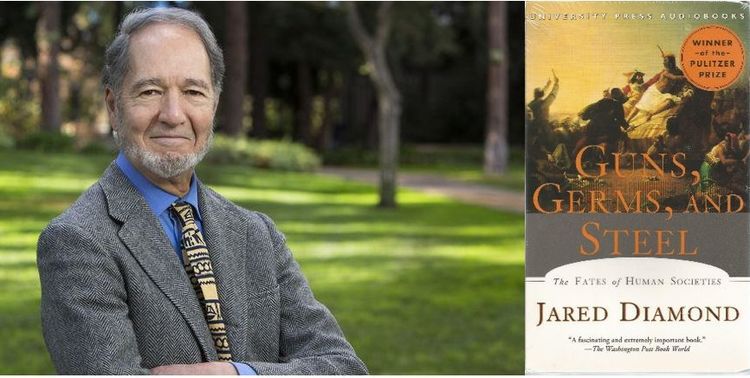


By Steve Sailer
12/30/2019
As we’ve all been informed over the last days by the teeming members of the Volunteer Auxiliary Thought Police, it’s White Supremacy for gentile whites to notice that Ashkenazi Jews have a higher average IQ score than white gentiles have, much less to speculate that there could be Darwinian reasons for this important feature of the modern world.
And yet the impressive 2005 paper “Natural History of Ashkenazi Intelligence,” co-authored by the much-denounced cultural and genetic anthropologist Henry Harpending, has always been taken seriously by the very smartest public intellectuals. Here are articles responding to it by Steven Pinker in The New Republic, Charles Murray in Commentary, and Scott Alexander, the most impressive new public intellectual to emerge in our now-ending decade, on his Slate Star Codex blog.
Today, I learned that one of their peers, Jared Diamond, author of the celebrated Guns, Germs, and Steel, anticipated some of this theory in a brief article a quarter of a century ago. From Nature in 1994:
HUMAN GENETICS
Jewish lysosomes
Jared M. DiamondNews & Views
Published: 24 March 1994
Nature volume 368, pages 291–292(1994)A LONG-standing puzzle of human population genetics has been the incidence of a dozen autosomal recessive diseases at high frequencies in eastern European (Ashkenazi) Jews. Best known are Tay-Sachs disease (which is always fatal) and Gaucher disease (which is often serious), both with heterozygote frequencies of several per cent. Why should Ashkenazi Jews, of all people, have been singled out by these genetic curses? …
One simple yet plausible explanation would be that Jews were singled out merely by chance. Deleterious genes may transiently rise to high frequencies in small populations through the founder effect or genetic drift. …
Yet it has always seemed suspicious that three of the common Ashkenazi diseases (Tay-Sachs, Gaucher and Niemann-Pick) all involve lipid storage resulting from defects in three separate lysosomal enzymes (hexosaminidase A, glucocerebrosidase and sphingomyelinase respectively). That seems to suggest that lightning has struck Jewish lysosomes too often to be a coincidence. But the argument is not conclusive, because three similar defects might have been encountered by chance in at least one human population if enough populations were scrutinized for enough diseases.
The case against coincidence would be strengthened if it could be shown that each
of those lysosomal diseases in turn had several origins among Jews. In 1979, in the book Genetic Diseases among Ashkenazi Jews, the geneticist Victor McKusick
pointed out that “If there are two or more different alleles for the hex-A [Tay-Sachs] mutation, which achieved high frequency in the Ashkenazim, this finding would be a powerful argument for selection since chance would not be likely to raise two or more alleles to significant frequencies” (p. 313 of ref. 1).In that same book several authors went on record as predicting that only a single allele would be found to account for the Ashkenazim’s high frequency of TaySachs or Gaucher disease. The first disease for which this prediction was proved wrong was Tay-Sachs, which is now known to be caused in Ashkenazi Jews by two distinct common mutations as well as by other rare ones. New studies have now reached a similar and even more striking conclusion for Gaucher, the commonest
of all the storage diseases• Five common mutations collectively account for about 97 per cent of Jewish Gaucher disease alleles. Each mutant allele has a measured or estimated heterozygote frequency of 0.05-2.8 per cent- far higher than could be sustained at equilibrium (in the face of deaths or debilitation from Gaucher) by recurrent mutations in the absence of any compensating selective advantage. Four of the mutant alleles occur in Jews in the context of only a single haplotype. That implies that the mutations arose in Jews recently, and only once, and have within a short time been pumped up to high frequencies by selection. Of those four mutations, all are rare or occur at much lower absolute frequencies in Jews than in non-Jews.In effect, lightning has struck Jewish lysosomes not once, not three times, but at least eight times. If your house is hit by lightning while a neighbour’s house goes unscathed, you may curse your bad luck, but if it happens eight times you should seek causative factors. In genetic terms, that means seeking some compensating
advantage of the deleterious gene, most likely in the heterozygote, as illustrated by the familiar example of sickle-cell haemoglobin conferring resistance to malaria. …What selective force could be acting on eastern European Jews but not on their non-Jewish neighbours? Specifically, what features of Jewish living conditions or lifestyle during the past 700 years could have conferred compensatory value on the genes for Gaucher, Tay-Sachs, Niemann-Pick and factor XI deficiency?
This conundrum has stimulated much discussion in print and even more
discussion not in print, The present stage is still one of speculative search for testable hypotheses, and not yet one of definitive hypothesis-testing. For instance, could being crammed into tuberculosis ridden urban ghettoes have placed eastern European Jews under much stronger selection for resistance to tuberculosis than their predominantly rural Gentile neighbours? …A second hypothesis is selection in Jews for the intelligence putatively required to
survive recurrent persecution, and also to make a living by commerce, because Jews were barred from the agricultural jobs available to the non-Jewish populationA related third possibility is sexual selection for increased reproductive success, because men with the qualities required to become rabbis were prized as husbands and would have tended to marry wealthy women capable of nourishing many children.
Of course, these factors are hypothetical, and other explanations are possible.
Identification of the selective factors responsible is unlikely to be easy.Jared M. Diamond is in the Department of Physiology, University of California Medical School, Los Angeles, California 90024, USA. This is his one-hundredth News and Views article.